#Frozen bubble for linux
Explore tagged Tumblr posts
Text
did you guys know it's possible to have entire super mario clones installed that take up only 1-5 MEGAbytes?? did you guys know?
#god i missed linux#i never knew how lightweight the games of my childhood were#shoutout to supertux and supertux kart#and pingus and frozen bubbles#the latter of which was only 140 KILObyes#KILO#crazy
0 notes
Text
Frozen bubble for linux

#FROZEN BUBBLE FOR LINUX MAC#
Remove bubbles fast enough, the board shifts down closer to theīottom. Level by eliminating all of the bubbles from the level. Match, your bubble becomes another bubble to eliminate. Of the bubbles connected below it will disappear. If you hit a bubble with a matching color, it and all Screen and attempt to hit a bubble at the top of the screen that has a Given a single colored bubble, and you aim from the bottom of the The object of Frozenīubble is to remove all of the different colored bubbles thatĪre arranged on the top of the screen ( Figure 7-10). Game similar to Puzzle Bobble or Bust-a-Move. Replay value, are often the simplest ones. Moreover, what was a bit weird was, other than me, everyone was named FINALFANTA.Some of the most fun games, the games that have the highest While we could easily get connected to the online server, there were only 7 games and 3 players online. While the game might sound to be custom made for kids, it shall work as a great stress buster if you manage to sneak the live DVD in your office :-) Moreover, you can also play against other players, on the internet, and show off your score to the community.
#FROZEN BUBBLE FOR LINUX MAC#
The game is currently available only for Linux and BSD, but a Windows and a Mac port are both in the works and should be available at some point in the future. If you would like to try Frozen Bubble, you can get it by going through your favorite Linux or BSD package manager or repository. If nothing else, it’s a good time killer when you’re bored or have little to do. Given the extra features of the multiplayer side of the game, it should provide you with more than enough of a challenge to keep things interesting for a long time to come.įrozen Bubble, while overly simple in many ways, is still a very good game and certainly worth your time to at least look into and maybe even play. So if you ever feel up to it, you can challenge your friends to a quick game. You can do player vs player side by side battle on the same machine, or over the internet. Also, if single player isn’t challenging enough for you, then you may want to look at the multi-player option. Since it’s flexible, if you want, make your own challenges. There are a few more than only require two or three well placed shots and the level is over.īut that doesn’t mean the game has to be boring. Not all the levels are like this though, but there are a couple. Being able to win a level with just one shot seems a bit counter productive to the goal of making a fun and entertaining game in my honest opinion. In fact, some of the levels are so simple that just one single well placed shot and the level is over. And even then you’re not really truly challenged until you reach level thirty. It’s not until you get up around level 20 that things start becoming a challenge. I say this because the game really provides you with essentially no challenge for the first 15 or 20 levels. But to some extent, I think the creators went a bit too far to keep the concept of simple. This way anyone from two to seventy two will find the game fun and relaxing to play. Since it’s a pop-cap type game, you’re typically not going to be confronted with complex puzzles or crazy hoops you have to jump through to win. You’re meant to have that one basic task to perform within the game. While that might seem a bit too simple, that’s actually intentional.

0 notes
Text
Frozen bubble for linux

#Frozen bubble for linux how to
#Frozen bubble for linux mac os
#Frozen bubble for linux install
On the Applications menu, point to Games and click Frozen-Bubble to launch the game. Therefore, if you are playing this game at your workplace and do not want other people to know, ensure that the speakers are turned off before launching this game.ġ. This game does not have the option to turn off the sound.
#Frozen bubble for linux install
Frozen-Bubble is not in the list of default games so you should install it from the Universe repository. You can play this game with another player on your Local Area Network (LAN) or invite a player on the Internet to play. Package: frozen-bubble Version: 2.1.0-1 Severity: normal Please type your report below this line if I start a LAN game and a remote server in local lan host a game I cant find the game. Frozen-Bubble is a clone of the popular Puzzle Bobble game and features 100 single-player levels, two-player mode, music and striking graphics. If three bubbles of the same color connect, they are removed from the screen. The software has been developed on Linux, but other coders have ported it to Windows, OS X, FreeBSD, and NetBSD.In Frozen-Bubble, you attempt to shoot bubbles into groups of the same colour to cause them to pop. Frozen Bubble is an arcade-style puzzle game that involves shooting bubbles from the bottom of the screen toward a collection of bubbles at the top of the screen. System requirements: SDL, SDL_image, SDL_mixer, sdlperl, and SDL_Pango. Developed in 2002 by William Cottenceau and his team, the game quickly became cult under the Linux.
3 professional quality 20-channel music Frozen Bubble is a free version of the game Puzzle Bobble.
Tí- a víceprvkové skupinky stejné barvy odpadají, a to vetn kuliek, které na n jsou pípadn navázány. Frozen-bubble Download for Linux (deb, eopkg, pkg, rpm, tgz, txz) Download frozen-bubble linux packages for ALT Linux, CentOS, Debian, Fedora, FreeBSD, Mageia, NetBSD, openSUSE, PCLinuxOS, Slackware, Solus, Ubuntu. Úkolem hráe je vystelovat ze spodku hrací plochy smrem nahoru barevné kuliky (bubliny) a tvoit z nich skupinky stejné barvy. The default controlling mechanism is through the keyboard, but you can play with a joystick or a joypad. Frozen Bubble je open source logická poítaová hra podobná Puzzle Bobble.
#Frozen bubble for linux mac os
In 2-players or network mode, you have to get your opponent to “die” before you. Frozen Bubble is a free software Puzzle Bobble style computer game which is available on several operating systems including Linux, Windows, Mac OS X. In 1-player mode, the goal is to pop all the bubbles on the board as quickly as possible. Simply install the packages with yast or zypper. The game is released under the GNU General Public License. This version is presently for Linux only. Version 2.x offers multiplayer play via LAN and Internet. If some bubbles were sticked only on the popping clump, they fall. The original Frozen Bubble was written in Perl by Guillaume Cottenceau. If the shoot ends up having a clump of at least 3 bubbles of the same color, they all pop. The game mainly consists of firing randomly chosen bubbles across. The game mainly consists of firing randomly chosen bubbles across the board. The Frozen-Bubble game is a free software implementation of a popular arcade/reflex game. It features 100 single-player levels, a two-player mode, music and striking graphics. rpm files from the website but dont know which files to use.
#Frozen bubble for linux how to
Frozen Bubble is a clone of the popular “Puzzle Bobble” game, in which you attempt to shoot bubbles into groups of the same color to cause them to pop. May i know how to get the game frozen bubble working on linux Im trying to download the the.

0 notes
Text
Frozen bubble for linux

FROZEN BUBBLE FOR LINUX MAC OS
FROZEN BUBBLE FOR LINUX ANDROID
FROZEN BUBBLE FOR LINUX FREE
The game is released under the GNU General Public License. The chain reaction mode (where fallen bubbles will zoom back up to complete triplets, possibly falling more bubbles and thus creating more combos) is also available in network mode as of Version 2.0, and greatly changes the mechanics of the game.
FROZEN BUBBLE FOR LINUX MAC OS
This version is presently for Unix-like operating systems (such as Linux, Mac OS X, etc.) only. Two players can also play on the same computer. Version 2.0 offers multiplayer play via LAN and Internet. Such groups disappear and the object is to clear the whole screen in this way before a bubble passes a line at the bottom.
FROZEN BUBBLE FOR LINUX FREE
Like many popular free software/open source games, it features penguins a la Tux, who in this game shoot the coloured frozen bubbles to form groups of the same colour. The game features 100 levels and includes a level editor. The original Frozen Bubble was written in Perl by Guillaume Cottenceau, and uses the Simple DirectMedia Layer (SDL) library. There is also a single player Java applet version.
FROZEN BUBBLE FOR LINUX ANDROID
Mouse for level editorĬredits | Soundtrack | Codes | Walkthroughįrozen Bubble is a free software Puzzle Bobble style computer game which is available on several operating systems including Linux, Windows, Mac OS X, the Symbian Series 60, Windows Phone 7 and Android line of smartphones. Linux, Windows (version 1.0.0 only), Mac OS X, Java, Symbian, gp2x, FreeBSD, NetBSD, Windows Phone 7 Continued abuse of our services will cause your IP address to be blocked indefinitely.Single player, Two player, Multiplayer (2 to 5 players) Please fill out the CAPTCHA below and then click the button to indicate that you agree to these terms. If you wish to be unblocked, you must agree that you will take immediate steps to rectify this issue. If you do not understand what is causing this behavior, please contact us here. If you promise to stop (by clicking the Agree button below), we'll unblock your connection for now, but we will immediately re-block it if we detect additional bad behavior.
Overusing our search engine with a very large number of searches in a very short amount of time.
Using a badly configured (or badly written) browser add-on for blocking content.
Running a "scraper" or "downloader" program that either does not identify itself or uses fake headers to elude detection.
Using a script or add-on that scans GameFAQs for box and screen images (such as an emulator front-end), while overloading our search engine.
There is no official GameFAQs app, and we do not support nor have any contact with the makers of these unofficial apps. Continued use of these apps may cause your IP to be blocked indefinitely. This triggers our anti-spambot measures, which are designed to stop automated systems from flooding the site with traffic.
Some unofficial phone apps appear to be using GameFAQs as a back-end, but they do not behave like a real web browser does.
Using GameFAQs regularly with these browsers can cause temporary and even permanent IP blocks due to these additional requests.
If you are using Maxthon or Brave as a browser, or have installed the Ghostery add-on, you should know that these programs send extra traffic to our servers for every page on the site that you browse.
The most common causes of this issue are: Your IP address has been temporarily blocked due to a large number of HTTP requests.

0 notes
Text
Visually Testing React Components using the Eyes Storybook SDK
Guest post by Gil Tayar, Senior Architect at Applitools
React is, first and foremost, a library for creating reusable components. But until React Storybook came along, reusability of components between applications was very limited. While a library of common components could be created, it was very difficult to use, as there was no useful way of documenting it.
Yes, documenting the common components via a Readme file is possible, even useful. But a component is, in its essence, something visual. A Readme file just doesn’t cut it, neither for a developer and definitely not for a designer that wants to browse a library of shared components and choose the one that fits their purpose.
This limited the usefulness of React’s component reusability .
And then React Storybook came along. React Storybook has changed the way many companies approach React by allowing them to create a library of components that can be visually browsed so as to be able to pick and choose the component they want:
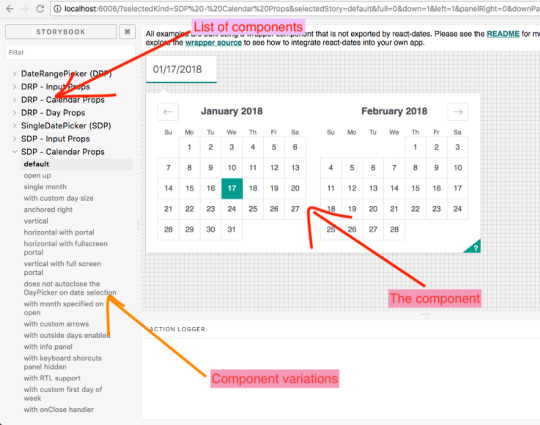
React Storybook
Finally, a real library of shared components can be created and reused across the company. And examples abound, some of them open-source: from airbnb’s set of date components to Wix’s styled components.
But a library of widely used company-wide components brings its own set of problems: how does one maintain the set of components in a reliable way? Components that are internal to one application are easily maintained — they are part of the QA process of that application, whether manual or automated. But how does one change the code of a shared component library in a reliable manner? Any bug introduced into the library will immediately percolate to all the applications in the company. And in these agile days of continuous delivery, this bug will quickly reach production without anybody noticing.
Moreover, everyone in the company assumes that these shared components are religiously tested, but this is not always the matter. And even when they are tested, it is usually their functional aspect that is tested, while testing how they look is largely ignored.
Testing a Shared Library
So how does one go about writing tests for a library of shared components? Let’s look at one of the Shared Components libraries out there — Airbnb’s React Dates. I have forked it for the purpose of this article, so that we can look look at a specific version of that library, frozen in time.
Let’s git clone this fork:
$ git clone [email protected]:applitools/eyes-storybook-example.git $ cd eyes-storybook-example
To run the storybook there, just run npm run storybook, and open your browser to http://localhost:6006.
To run the tests, run the following:
$ npm install $ npm test
This runs the tests, which generate the following output:
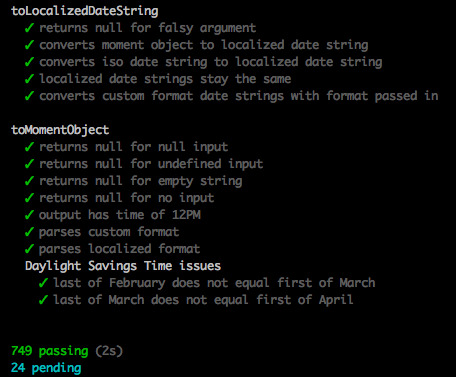
Airbnb React Dates test output
Wow! 750 tests. I have to say that this component library is very well tested. And how do I know that it is very well tested? It’s not just because there are a lot of tests, but also (and mainly!) because I randomly went into some source file, changed something, and ran the tests again.
Let’s try it. Change line 77 in file: src/components/CalendarDay.jsx to:
if (!onDayMouseEnter) onDayMouseEnter(day, e);
(I just added the if to the line). Now let’s run the tests again using npm test:
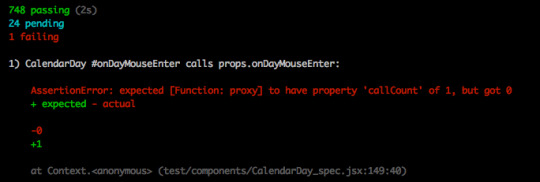
Tests failing due to a change in the code
Perfect! The tests failed, as they should. Really great engineering from the Airbnb team.
(if you’re following with your own repository, please undo the change you just made to the file.)
Functional Testing Cannot Catch Visual Problems
Let’s try again. Edit line 6 in the file src/svg/arrow-right.svg, by changing the first M694 to M94, thus:

Now let’s run the tests again using npm test:

Oops. They’re passing. We’ve changed the source code for the components, and yet the tests pass.
Why did this happen? Because we changed only the visual aspect of the components, without changing any of the functional aspect of it. And Airbnb does only functional testing.
This is not to denigrate the wonderful engineers at Airbnb who have given us this wonderful libraries (and other open-source contributions). This library is tested in a way that should make Airbnb proud. And I am sure that manual testing of the components is done from time to time to ensure that the components are OK.
(if you’re following with your own repository, please undo the change you just made to the file.)
Visual Testing of a Shared Library
So how does one go about testing the visual aspects of the components in a shared library? Well, if you’re using React Storybook, you’re in luck (and if you’re building a shared component library, you should be using React Storybook). You are already using React Storybook to visually display the components and all their variants, so testing them automatically is just a simple step (are you listening, Airbnb? 😉).
We’ll be using Applitools Eyes, which is a suite of SDKs that enable Visual Testing inside a variety of frameworks. In this case, we’ll use the Applitools Eyes SDK For React Storybook (yes, I know, a big mouthful…)
(full disclosure— I am a developer advocate and architect for Applitools. But I love the product, so I have no problem promoting it!)
To install the SDK in the project, run:
npm install @applitools/eyes.storybook --save-dev
This will install the Eyes SDK for Storybook (locally for this project). If you’re following with your own repository, please undo the changes you made to the files. or otherwise you will get failures. To run the test, just run:
./node_modules/.bin/eyes-storybook
You will get this error:

Yup. To use the Eyes SDK, you need an API Key, which you can get by registering at the Applitools site, here. Once you have that, login and go to the Eyes admin tool, here. You will find the API using the following menu:
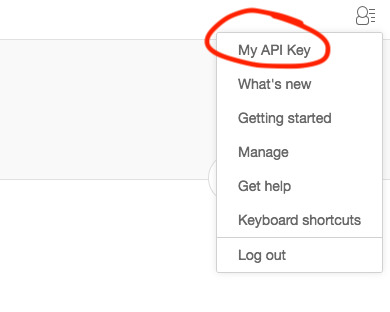
Getting the Applitools API Key
To make Eyes Storybook use the API key, set the environment key APPLITOOLS_API_KEY to the key you have:
// Mac, Linux: $ export APPLITOOLS_API_KEY=your-api-key
// Window C:\> set APPLITOOLS_API_KEY=your-api-key
Now run it again:
./node_modules/.bin/eyes-storybook
Eyes storybook will run Chrome headless, open your storybook, take a screenshot of all your components and variants, and send them to the Applitools service. When the test ends, as this is the first test, it will establish that these screenshots are the baseline against which all other tests will be checked against. You can check the results with the link it adds to the end of the tests, or just go to http://eyes.applitools.com:
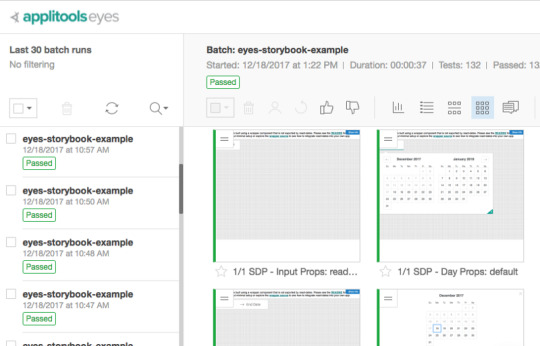
Visual testing results
Failing the Test
So let’s test if the change we made to the SVG will fail the test. Re-edit line 6 in the file src/svg/arrow-right.svg, by changing the first M694 to M94, thus:

Now let’s run the test again using ./node_modules/.bin/eyes-storybook.
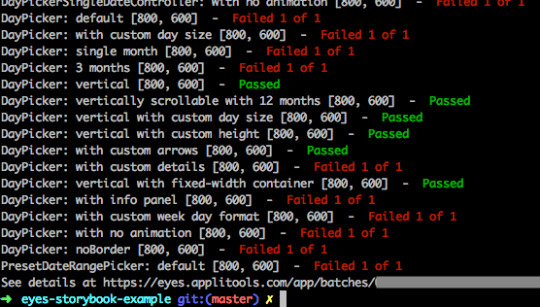
Failing Eyes Storybook test
Success! Or rather failure! The test recognized that some of the component screenshots differed from the baseline ones we created earlier. We can see the result of the diffs in the Applitools Eyes management UI:

Showing diffs of components in Storybook
We can either select these changes as the new baseline (which in this case we don’t want to!) or fix the bug and run the test again, in which case it will be green.
And that is the beauty of Storybook. Because it enables you to create a central repository of components, it feeds three birds with one bird feed (I’m sorry, I can’t kill three birds, even if it is with one stone…):
Creating and documenting a shared React components library, with little effort.
Testing that the functionality of the components works (albeit with lots of effort)
Visually testing the components with literally zero code.
Summary
React Storybook is a game changer for frontend development— it enables the creation and maintenance of a shared component library for the whole company.
And the best thing about React Storybook is that if you’ve already invested the effort to set it up, you get a suite of tests that check the visual look of your components… for free!
h2, h3, h4, h5 { font-weight: bold } figcaption { font-size: 10px; line-height: 1.4; color: grey; letter-spacing: 0; position: relative; left: 0; width: 100%; top: 0; margin-bottom: 15px; text-align: center; z-index: 300; } figure img { margin: 0; }

About the Author: 30 years of experience have not dulled the fascination Gil Tayar has with software development. From the olden days of DOS, to the contemporary world of Software Testing, Gil was, is, and always will be, a software developer. He has in the past co-founded WebCollage, survived the bubble collapse of 2000, and worked on various big cloudy projects at Wix. His current passion is figuring out how to test software, a passion which he has turned into his main job as Evangelist and Senior Architect at Applitools. He has religiously tested all his software, from the early days as a junior software developer to the current days at Applitools, where he develops tests for software that tests software, which is almost one meta layer too many for him. In his private life, he is a dad to two lovely kids (and a cat), an avid reader of Science Fiction, (he counts Samuel Delany, Robert Silverberg, and Robert Heinlein as favorites) and a passionate film buff. (Stanley Kubrick, Lars Von Trier, David Cronenberg, anybody?) Unfortunately for him, he hasn’t really answered the big question of his life - he still doesn't know whether static languages or dynamic languages are best.
0 notes